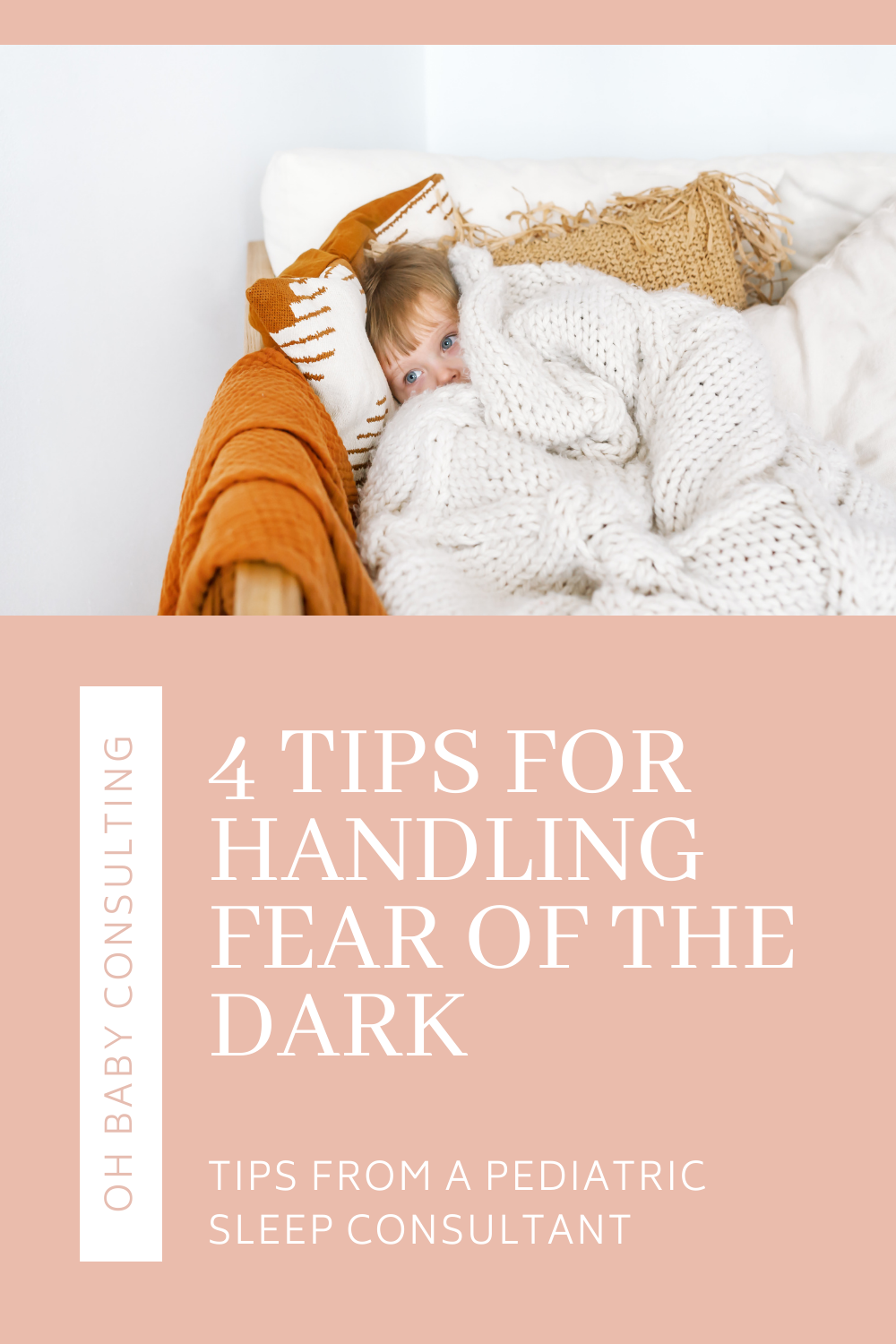4 Tips for Handling Fear of the Dark
One common misconception I hear a lot is that babies need nightlights because they are afraid of the dark. While it’s unlikely that your baby is actually experiencing fear of the dark, your toddler might just be.
Fear of the dark usually begins around age 2 as a toddler’s thinking matures, their long-term memory capacity grows, and their imagination develops. Toddlers also have more experience with the world (be it in their own lives or the stories they see on TV or hear in books) and are more aware that there are things out there that are scary. As adults, we understand that the dark isn’t inherently dangerous, but for a toddler they don’t have the same historical reassurances to know that they are perfectly safe after the lights are turned out at bedtime.
Even if your toddler has always been a great sleeper, they may suddenly start requesting that you stay with them as they fall asleep or yell out for you multiple times a night needing you to check for monsters. They may start asking that you leave the lights on at bedtime or even get out of bed and turn them on themselves in the middle of the night.
This can be a tough process navigate; you don’t want to dismiss potentially very real fears, but you also don’t want to affirm that your child has something to be afraid of in the first place. I also know that you may want them to get the sleep they need without needing you to be heavily involved in the process.
Here are 4 tips you can use to navigate bedtime fears and nighttime scaries.
1. Avoid “monster repellant”
Though widely popular and even recommended by many professionals, I’m really not a big fan of “monster spray” (or even things like nightly closet checks.) In a way, it confirms to your child that there is something to be afraid of. “There is a very real threat of monsters here. They’re definitely super scary. They tend to live in children’s closets. I don’t see one at the moment but using this spray will keep them away.” Actually, no, that’s not the message we want to send. Instead…
2. Take their fears seriously
Dismissing your child’s fears as irrational or unfounded without conversation isn’t all that helpful. Instead I recommend asking questions which lets them know that you’re taking them seriously – something that is very reassuring. You can then help them understand that though their fears seem very real, many things your child deems as “threats” aren’t actually probable. Remind them that it is your job as their parent to protect them and keep them safe while they sleep. As a bonus, digging into their concerns about the dark and why it’s frightening them can help you get to the root of the issues and then address those.
For example, if your child expresses that he is afraid of monsters but after some conversation you realize that what your child thinks is a monster is actually just shadows that are cast by headlights from cars driving by, you can tackle this root cause with either some education (turning off the lights and watching the cars drive by) or room-darkening blinds or curtains to eliminate any opportunities for shadows at all.
3. Spend some quality time together…in the dark
For a lot of toddlers and preschoolers, bedtime is the only time of the day that they are left alone; the rest of the day is spent in close proximity to parents, babysitters, teachers, and other caregivers. Bedtime is also likely the only time they are exposed to total darkness, so it makes sense that these two things can combine into somewhat of a perfect storm of anxiety.
One fun and effective way to ease some of this apprehension about the dark is to spend some time in the dark together outside of bedtime. Whether that’s reading books under the covers with only a flashlight, playing hide and seek with the lights off, or making shadow-puppets on the wall, creating some positive experiences in low-light situations will help your toddler feel more confident when the lights are off.
4. Use a nightlight
You might be surprised that I’m recommending adding a nightlight to your child’s sleep space since I talk so much about how important darkness is to good sleep, but I do think that there is a time & a place for nightlights, and when your toddler or preschooler is expressing true fears of the dark and you’ve exhausted other options, this is one of them!
The best type of nightlight to choose is one with a red/amber glow. On the light/color spectrum, there are some colors of light that will disturb your sleep more than others. For example, blue light (like the light from screens) is more disruptive than warmer colors on the spectrum like red or orange. (This is because it interferes with the production of melatonin – the sleepy hormone – and when that cannot rise in sufficient quantities, it can cause sleep struggles.)
If you’re using a nightlight that plugs into the wall, you can situate it behind a piece of furniture so that it is more ambient lighting vs. direct lighting, but I actually prefer to use either a dimmable nightlight with the ability to change colors (like the Hatch Baby Rest) or dimmable salt lamp (which gives off a red/orange glow.) You’ll want to dim the lamp all the way to the lowest setting which should be just enough light to keep your child confident and comfortable in a room that’s not totally dark but not too bright that it disrupts their sleep.
If your little one’s sleep struggles go beyond nighttime fears or you’ve fallen into unsustainable habits that you are looking to change, please get in touch! With private 1:1 coaching, we can work together to tackle your child’s sleep struggles and help everyone start sleeping soundly again.
If you’re exhausted, totally overwhelmed by your child’s sleep habits, or looking for answers to the sleep questions that keep you up at night (literally), then you’ve come to the right place. I’m Jamie, founder of Oh Baby Consulting, and my goal is to help your family get the sleep you need to not just survive, but thrive!

